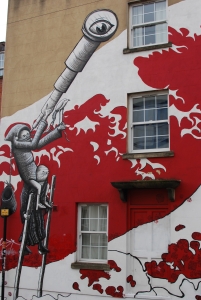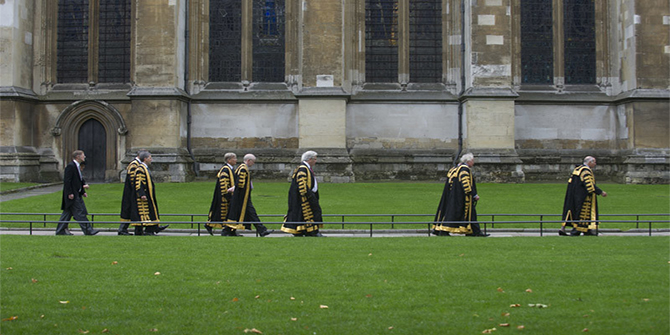 The state of Britain’s town centres is back on the political agenda, as many of our towns and cities continue in their struggle to survive, regenerate and prosper as social centres. In this article, Julian Dobson shows the failure of depending on market forces to ‘solve’ the town centre problem. He writes that we need to rethink how space is used, who has access to it and owns it, and where the economic, social and environmental benefits flow.
The state of Britain’s town centres is back on the political agenda, as many of our towns and cities continue in their struggle to survive, regenerate and prosper as social centres. In this article, Julian Dobson shows the failure of depending on market forces to ‘solve’ the town centre problem. He writes that we need to rethink how space is used, who has access to it and owns it, and where the economic, social and environmental benefits flow.
Last month, local leaders across the UK who had pinned their hopes on plans to regenerate landmark sites in partnership with Tesco had to bin years of planning and negotiations: the giant retailer pulled out of schemes to develop 49 sites, dumping promises to create at least 8,000 jobs, more than 1,100 new homes and nearly 2.5m square feet of retail space. Wolverhampton’s Royal Hospital, derelict for 14 years, was just one of the victims. Less than a year ago the local council leader, Roger Lawrence, was hailing a £65 million scheme to bring the site back to life, create hundreds of jobs and revitalise the city centre. Yet last month, local MP, Pat McFadden called Tesco’s decision to walk away from the redevelopment: “a betrayal of the people of Wolverhampton and a clear breach of the promise made to the people of the city.”
Frustration
Frustration continues to typify the debate on the future of town centres. Local and national leaders place their faith in private developers and big retailers to rescue towns from decline, only to have those hopes dashed time and again. Speaking in Parliament on 10 February Barry Sheerman, MP for Huddersfield, declared that town centres were: “threatened by all sorts of forces: not exactly evil forces, but forces of change.” His roll of shame included supermarkets, betting shops and takeaway food stores. Two days later Northern Ireland’s minister for social development, Mervyn Storey, took up a similar theme at the Northern Ireland Town Centre Futures conference. He argued: “[there is an] urgent need to radically rethink how we regenerate and revitalise our town centres as multifunctional social centres.”
There are signs that this is starting to happen. In Bangor, Northern Ireland, artists have worked with the local council to bring a run-down parade of shops back to life. In Falkirk, a series of festivals have created a buzz and sense of local pride. But the real changes we need go much deeper than that. They involve rethinking how space is used, who has access to it and owns it, and where the economic, social and environmental benefits flow.
Naive faith
The decline of our town and city centres has taken decades, exacerbated by social and technological changes, unintelligent planning decisions, and a naive faith that ‘the market’ will solve the problems it has created. It may take as long to reconfigure town centres in ways that generate lasting local benefits.

But in the meantime there are powerful symbolic actions that can demonstrate the direction of travel that’s required. In Todmorden, West Yorkshire, local people are rethinking public space and creating a new narrative for their town by growing and sharing food. In Bristol, street artists have pioneered alternative futures for Stokes Croft, an area neglected for years by the city council and private landowners.
On London’s South Bank, Coin Street Community Builders has shown how creating affordable homes for local people rather than yet another bleak office city can bring lasting benefits for everyone, opening up the riverside as a public space and preserving a diverse community in a city that is increasingly the preserve of the affluent. Such symbolic actions can signpost new ways of thinking of urban space as part of the ‘commons’, the shared resources from which we all benefit and for which we all share a responsibility.
The challenge of town centres is a microcosm of the challenges of 21st century society: how to create an economy that works for all, how to create good places to live in, how we construct our identity in a world in which life is increasingly commoditised. There aren’t any quick and easy solutions, but despite the continued angst over the future of our towns and cities I believe there are many reasons to be hopeful. That hope is found in the places where people have been ready to challenge the assumption that wealth will trickle down to localities from corporate activity, and where they have begun to define the value of places and spaces on their own terms and in response to local needs.
Note: This article was originally published on the Policy Press blog and gives the views of the author, and not the position of the British Politics and Policy blog, nor of the London School of Economics. Please read our comments policy before posting. Featured image credit: Nick CC BY 2.0
 Julian Dobson is a writer and researcher whose book
Julian Dobson is a writer and researcher whose book ![How to save our town centres [FC]](https://policypress.files.wordpress.com/2015/02/how-to-save-our-town-centres-fc.jpg?w=97&h=150) How to Save Our Town Centres is published by Policy Press). You can find Julian on twitter @urbanpollinator
How to Save Our Town Centres is published by Policy Press). You can find Julian on twitter @urbanpollinator








Well it’s all well and good to write articles like this but unfortunately there’s no real suggestions, or even substance in it to say what specifically has been done elsewhere or more importantly whether those broad ideas are actually working. That’s the frustrating thing. The first responder is quite on the money. Town centres are going to be turned over to housing. Mostly everyone does shop online, it remains to be seen how well this works out for this generation when it gets older (in terms of accessibility and technology) but one would assume having items delivered is going to be much easier for an ageing population generally. Those same people who do complain about town centres are the ones who’d quite happily go back to doing their online shopping immediately afterwards. The decline of town centres is a long painful death, the transition needs to be sped up, it can only happen when people get over themselves and acknowledge that.
The answer is actually quite simple. Local authorities need to stop clutching onto the past and stop focusing on shopping as being the primary reason people visit town centers. Lifestyle shopping has moved online and will continue to do so. To bring town centers back to life, give people a reason to visit the town center in the form of lifestyle, entertainment and culture activities.
I really think Muenster,Germany has it spot I. A mix of shops from low to high end, boutique and independent shops, open playground/sandpit areas in the centre, great bike access and public transport,lovely cafes that create an ambience etc, large weekly markets with great selection that is affordable…clean streets-and overhangs in front of the shops which means you can avoid getting soaked.
Parking charges should be re-examined as it can make it one more reason to just go to a large shopping mall and maybe there should be monthly or bi-monthly manager meetings with all the shops and council member responsible for improving the area to identify concerns and strategies to increase footfall and identify weaknesses